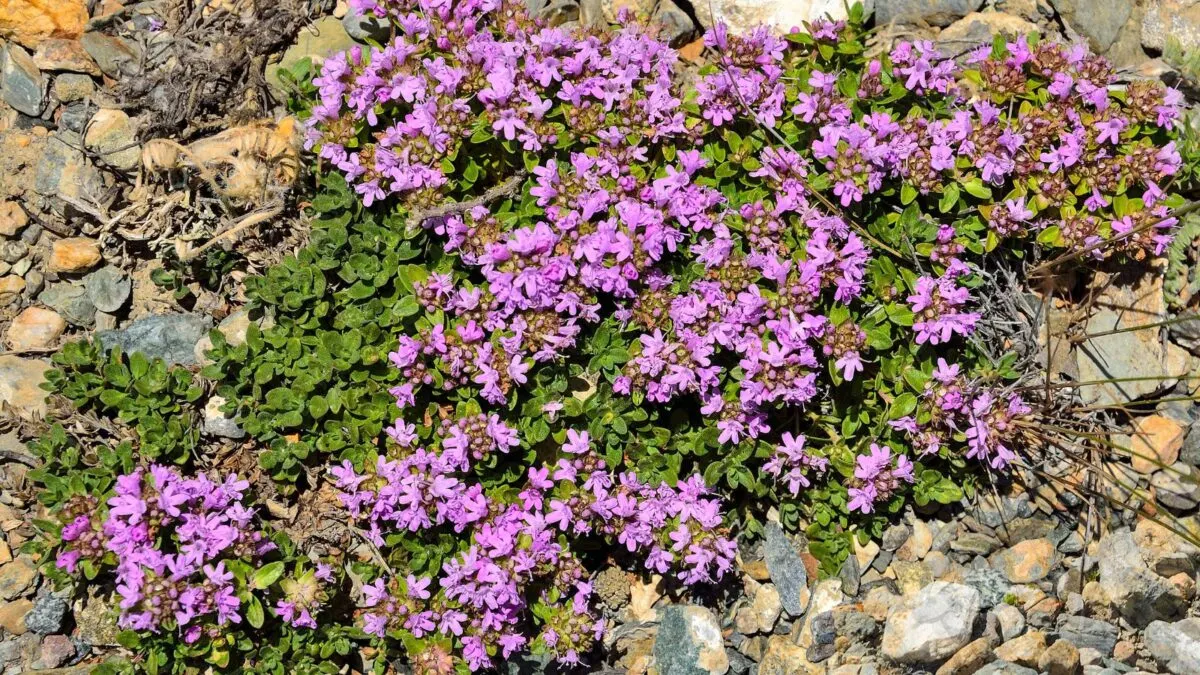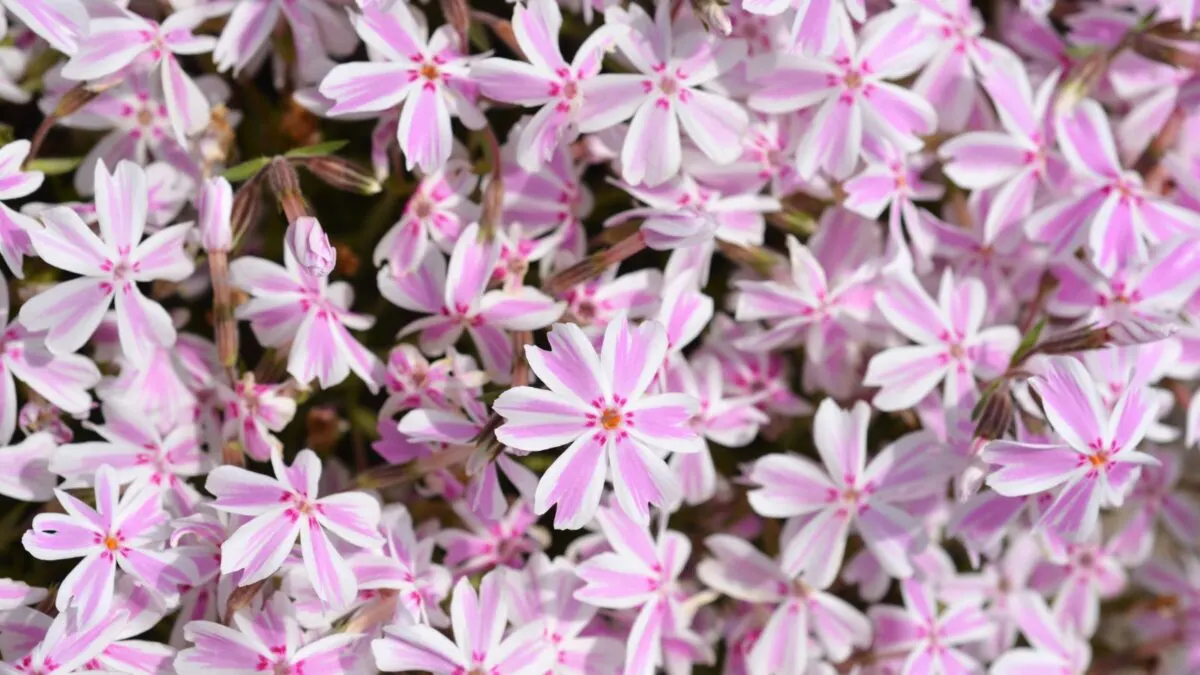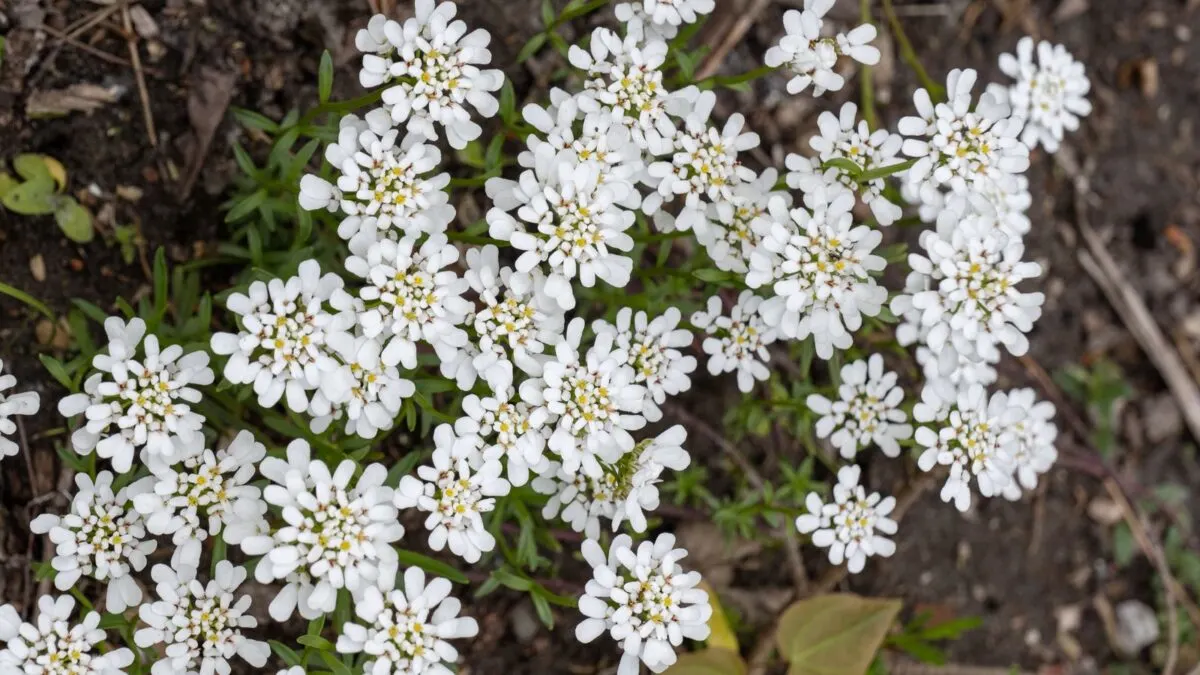Ground covers are infinitely useful plants. They can fill in empty spaces, provide a low-maintenance solution for hard-to-reach places, and even replace grass for a sustainable lawn alternative. Evergreen ground covers provide winter interest while flowering types offer a pop of color. These sprawling plants act as a living mulch, suppressing weeds, slowing evaporation, and preventing erosion. The following ground cover plants for full sun provide these benefits and more!
1. Creeping thyme (Thymus serpyllum)

Creeping thyme is as beautiful as it is functional. At just three inches tall, it makes an excellent lawn alternative or filler around stepping stones. Tiny pink flowers carpet the fragrant foliage in early summer and attract pollinators.
This perennial thrives in USDA hardiness zones 4-8. In addition to full sun, creeping thyme prefers well-drained soil with low fertility.
2. Perennial cornflower (Centaurea montana)

An erect, clump-forming flower, perennial cornflower is a taller ground cover at up to two feet high. It spreads by both stolons and self-sowing to form colonies. In summer and fall, fringed, purple-blue flowers bloom.
Perennial cornflower is easy to grow in poor to average soil with dry to medium moisture. It thrives in zones 3-8.
3. Lamb’s ear (Stachys byzantina)

Velvety soft, silver-green, elliptical leaves give lamb’s ear its name. This herbaceous perennial forms low, dense clumps that spread by rooting at stem nodes. Tiny, pinkish-purple flowers bloom in summer, but many gardeners prefer to remove them to enhance the foliage and compact growth.
Lamb’s ear grows in zones 4-9 and prefers dry to medium soils with excellent drainage in full to part sun.
4. Basket-of-gold (Aurinia saxatilis)

Basket-of-gold blooms in spring with masses of tiny yellow flowers in tight panicles. It forms a low mound, up to a foot tall, of narrow, gray-green leaves and spreads by self-sowing. This drought-tolerant perennial works especially well in rock gardens and xeriscapes.
For best results, plant basket-of-gold in full sun in average to sandy soil with excellent drainage. It is hardy in zones 3-7.
5. Creeping phlox (Phlox subulata)

Also called moss phlox, creeping phlox is an herbaceous perennial native to the eastern and central United States. It grows just six inches tall and has a dense, mat-like, spreading habit. In spring, small pink to blue flowers bloom in loose clusters, carpeting the plant. They then continue to bloom sparsely until frost.
Creeping phlox thrives in zones 3-9. It likes moist, humusy to sandy, well-drained soil and full to dappled sun. Learn more about growing creeping phlox.
6. Blue catmint (Nepeta x faassenii)

A taller, clump-forming ground cover, blue catmint grows 18 to 24 inches high and spreads as much as three feet wide. The spikes of lavender-blue flowers bloom from spring through summer. Both the flowers and the gray-green leaves are highly fragrant. A sterile hybrid, blue catmint will not self-sow.
This drought-tolerant perennial prefers full sun to part shade and well-drained soil. It is hardy in zones 5-9.
7. Stonecrop (Sedum rupestre)

Stonecrop, or sedum, is an upright, spreading succulent with fleshy, evergreen leaves. Sedum rupestre grows to just four to six inches high but spreads up to two feet wide. The cylindrical, pointed, gray-green or yellow leaves may become reddish in autumn, and small yellow flowers bloom in summer.
Stonecrop grows in zones 5-8 and likes well-drained soil in full sun. It does well in rocky soil and tolerates light shade and drought.
8. Wall germander (Teucrium chamaedrys)

A shrubby, low-growing evergreen herb in the mint family, wall germander averages six to 18 inches tall. It spreads by rhizomes and, like mint, can be difficult to control. Bright pink flowers bloom in spikes in late spring and summer, attracting bees.
Wall germander thrives in zones 5-9 in full sun and well-drained soil. It will tolerate poor soil and drought but not wet soil.
9. Rockspray cotoneaster (Cotoneaster horizontalis)

Rockspray cotoneaster is a low-growing shrub with a horizontal growing habit. It only grows up to three feet high but sprawls as wide as eight feet. White to pink flowers bloom in spring, followed by red berries. In cooler regions, the foliage turns red-purple in fall, while it remains semi-evergreen to evergreen in warmer areas.
This shrub prefers moist, well-drained soil in full sun. It grows best in zones 5-7 but may also survive up to zone 9 with afternoon shade and regular watering.
10. Hardy ice plant (Delosperma cooperi)

From summer into fall, the hardy ice plant produces masses of showy, purplish-pink flowers that resemble daisies. It grows just six inches tall and forms a carpet of small, fleshy leaves. It is evergreen in warmer regions.
Hardy ice plant thrives in zones 6-10. This drought-tolerant ground cover prefers full sun and dry, sandy soil.
11. Creeping juniper (Juniperus horizontalis)

Native to Canada and the northern United States, creeping juniper is an evergreen shrub that grows just 18 inches tall. It has long, trailing branches and blue-green, scale-like foliage. In winter, the foliage may become tinged with purple. The small round cones resemble blue berries.
Creeping juniper tolerates a range of soil types but prefers moderately poor, sandy or rocky soil with good drainage in full sun. It grows in zones 3-9.
12. Candytuft (Iberis sempervirens)

The cute name of candytuft matches is cheerful white flower clusters, which bloom from spring to midsummer. This herbaceous perennial or subshrub grows up to a foot tall with a sprawling, mounding habit. It is a semi-evergreen to evergreen with narrow, dark green, leathery leaves.
Candytuft prefers moist, well-drained soil in full sun and will tolerate drought. It thrives in zones 3-8.
Ground Cover Plants for Slopes

These plants grow densely and often quickly, covering the ground to shade out weeds and stabilize banks, preventing erosion.
Here’s a list of ground cover perfect for slopes.
